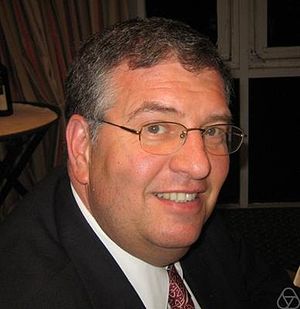| Jewiki unterstützen. Jewiki, die größte Online-Enzyklopädie zum Judentum.
Helfen Sie Jewiki mit einer kleinen oder auch größeren Spende. Einmalig oder regelmäßig, damit die Zukunft von Jewiki gesichert bleibt ... Vielen Dank für Ihr Engagement! (→ Spendenkonten) |
How to read Jewiki in your desired language · Comment lire Jewiki dans votre langue préférée · Cómo leer Jewiki en su idioma preferido · בשפה הרצויה Jewiki כיצד לקרוא · Как читать Jewiki на предпочитаемом вами языке · كيف تقرأ Jewiki باللغة التي تريدها · Como ler o Jewiki na sua língua preferida |
William Goldman (Mathematiker)
William Mark Goldman (* 1955 in Kansas City) ist ein US-amerikanischer Mathematiker, der sich mit Geometrie befasst.
Goldman studierte an der Princeton University mit dem Bachelor Abschluss 1977 und wurde 1980 an der University of California, Berkeley bei Morris W. Hirsch (und William Thurston) promoviert (Discontinuous groups and the Euler class).[1] Als Post-Doktorand war er an der University of Colorado und 1981 bis 1983 Moore-Instructor am Massachusetts Institute of Technology. Anschließend war er bis 1986 Assistant Professor am MIT. Seit 1986 ist er Associate Professor und ab 1990 Professor an der University of Maryland in College Park. Er ist dort Direktor und Mitgründer des Experimental Geometry Lab, das Software für das Studium niedrigdimensionaler Mannigfaltigkeiten entwickelt.
Er war Gastwissenschaftler am MSRI und am Institute for Advanced Study (2008) und 1989 Gastprofessor in Oxford. 2010 war er Invited Speaker auf dem Internationalen Mathematikerkongress in Hyderabad (Locally homogeneous geometric manifolds).
Er befasst sich seit seiner Diplomarbeit mit verschiedenen geometrischen Strukturen auf Mannigfaltigkeiten und deren Klassifizierung. Beispielsweise klassifizierte er mit Suhyoung Choi reelle projektive Strukturen auf kompakten Flächen.[2]
1983 klassifizierte er mit David Fried affine kristallographische Gruppen in drei Dimensionen, [3] den klassischen Fall von Schoenflies und Fjodorow für Isometrien auf affine Transformationen erweiternd.
2003 bis 2013 war er Herausgeber von Geometriae dedicata.
2012 wurde er Fellow der American Mathematical Society.
Schriften
- Complex hyperbolic geometry, Clarendon Press, Oxford 1999
- Locally homogeneous geometric manifolds, ICM 2010
- mit Morris Hirsch: A generalization of Bieberbach's theorem, Invent. Math. 65, 1981/82, S. 1–11.
- Conformally flat manifolds with nilpotent holonomy and the uniformization problem for 3-manifolds, Transactions of the American Mathematical Society 278 (1983), 573--583.
- The symplectic nature of fundamental groups of surfaces, Advances in Mathematics 54 (1984), 200--225
- Invariant functions on Lie groups and Hamiltonian flows of surface group representations, Invent. Math. 85 (1986), 263–302
- Topological components of spaces of representations, Invent. Math. 93 (1988), 557–607
- Convex real projective structures on compact surfaces, Journal of Differential Geometry 31 (1990), 791--845.
- Ergodic theory on moduli spaces, Annals of Mathematics, Band 146, 1997, S. 475–507.
- What is a projective structure ?, Notices AMS, 2007, Nr.1
Weblinks
Einzelnachweise
- ↑ Mathematics Genealogy Project
- ↑ Choi, Goldman The Classification of Real Projective Structures on compact surfaces, Bull. Amer. Math. Soc. 34 (2) (1997), 161–170, Online
- ↑ Fried, Goldman: Three-dimensional affine crystallographic groups, Advances in Mathematics 47 (1983), 1--49.
| Personendaten | |
|---|---|
| NAME | Goldman, William |
| ALTERNATIVNAMEN | Goldman, William Mark (vollständiger Name) |
| KURZBESCHREIBUNG | US-amerikanischer Mathematiker |
| GEBURTSDATUM | 1955 |
| GEBURTSORT | Kansas City |
| Dieser Artikel basiert ursprünglich auf dem Artikel William Goldman (Mathematiker) aus der freien Enzyklopädie Wikipedia und steht unter der Doppellizenz GNU-Lizenz für freie Dokumentation und Creative Commons CC-BY-SA 3.0 Unported. In der Wikipedia ist eine Liste der ursprünglichen Wikipedia-Autoren verfügbar. |
